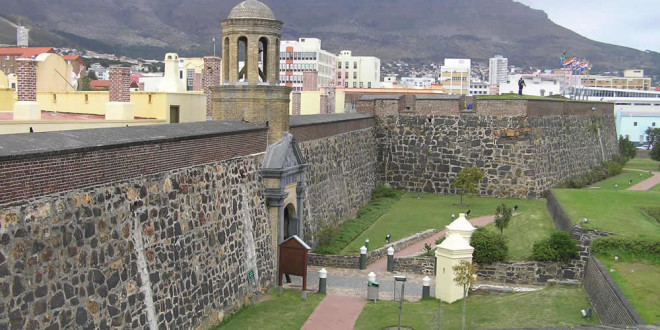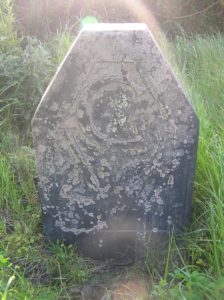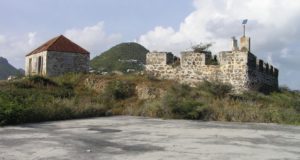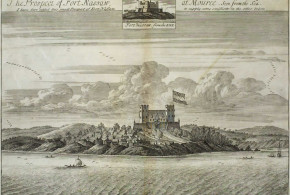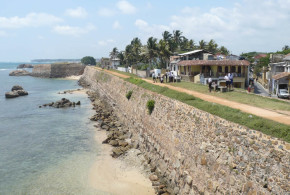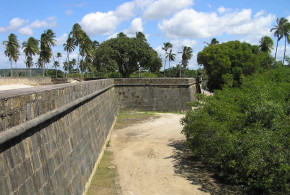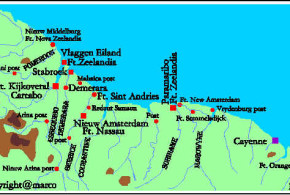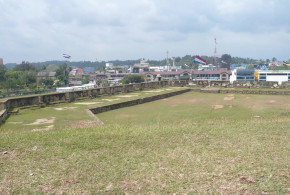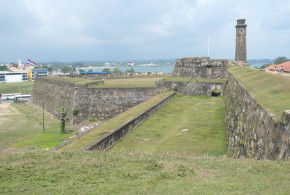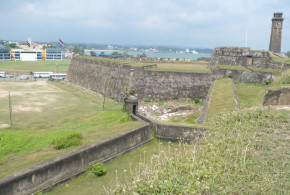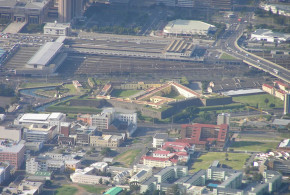Written by Marco Ramerini. English text revision by Dietrich Köster.
If you know something on colonial remains or if you have photos of such remains – they may be anywhere in the world -, send them to me. I’ll be happy to publish them on this website. Thank you. Marco. My e-mail is on the home page.
ANGOLA
Dutch surnames.
GHANA
Dutch surnames (Vanderpuye, Plange, van Hien)
Elmina: Fort São Jorge da Mina, Fort Conradsburg (St. Jago) (1652-1665), Dutch reformed church.
Axim: Fort Santo Antonio.
Sekondi: Fort Oranje (1670-1675).
Shama: Fort St. Sebastian (1665).
Mouri: ruins of Fort Nassau (1612-1634).
Beraku: Fort Goede Hoop (1705-1706).
Cormantin: Fort Amsterdam (1665-1685).
Princestown: ruins of Fort Hollandia or Brandenburgher Gross-Friedrichsburg.
Commenda: ruins of Fort Vredensburg.
Butre: ruins of Fort Batenstein.
Akwida: Fort Dorothea.
Accra: Fort Crevecoeur (F. Ussher) the original Dutch fort is now almost invisible, just north of the fort is the so-called Dutch Accra (Ussher Town) with some old family houses of merchants of African and European descent.
Apam: Fort Patience or Leydsaamheid (1697).
Takorady: insignificant remains of Fort Witsen and of another Dutch fort.
MAURITIUS
Ferney: remains of Fort Frederik Hendrik and a small museum about the Dutch settlement; monument (1998) commemorating the place where the Dutch landed in 1598 at Vieux Port.
My thanks to Ivo van de Moosdijk for this information.
NIGERIA
Bonny: Dutch cannons with Dutch inscription, they were on some walls just like a fort but only one meter high on the shoreline; there were also some prison cells, may be the remains of a small village in typical Dutch style (eye witness of about 30 years ago (around the 1970s).
My thanks to Ap (P. Muts) for this information.
SENEGAL
Gorée : A few ruins of Fort Nassau (1628). Gorée is a UNESCO World Heritage site.
SIERRA LEONE
Freetown: The Dutch Admiral De Ruyter carved his name, naval rank, and the date (1664) into the bedrock at a place now called “King Jimmy Market” (a fish and produce market on the waterside near downtown Freetown). The “De Ruyter Stone,” as it is called in Sierra Leone, was uncovered early in the 20th century by workmen digging for a sewer line. As the inscription is in the bedrock, it could not be removed and was covered over again for its protection. The De Ruyter Stone is still covered today, though the Sierra Leone National Museum has put a wall around it to mark the spot. In the early 1960s an American Peace Corps volunteer, named Gary Schulze, exposed the De Ruyter Stone for the first time in many years and made a latex mould of the inscription. From this he prepared a plaster cast, which is now a permanent exhibit in the Sierra Leone National Museum. It is on display beneath a portrait of Admiral De Ruyter, Holland’s greatest naval hero.
My thanks to Joseph Opala for this information.
SOUTH AFRICA
Language (Afrikaans, Fly Taal Creole, Oorlans Creole), Boer or Afrikaner Community, Coloureds Community, Dutch surnames.
Cape Town, Kaapstad: Castle of Good Hope (1666-1679); Slave Lodge (1679); Church Groote Kerk (1704) with a carved pulpit dating from 1779 and remains of the six governors of the Dutch East India Company including those of Simon van der Stel and Ryk Tulbagh; Chavonnes Battery (a VOC fort built in 1724, buried in 1860 and rediscovered in 2000, a museum since 2008); Koopman de Wet House (a classic example of a Cape townhouse dating from 1701); Martin Melck House; Company Gardens (with a sundial dating from 1787); Old Town House (1755); Rust en Vreugd House; Groot Constantia; Mostert’s Mill (1796); Fort Wynyard; Lutheran Church (the old church, which was converted from a warehouse in 1780); Old Malay Quarter; Bo-Kaap Museum is located in a house built in 1760; De Tuynhuys (the President’s office, which has been restored to its original appearance in 1795); Old Supreme Court, the tombstones of Jan van Riebeeck and his wife Maria de la Quellerie can be seen on a wall of the courtyard.
West Coast National Park: VOC border sign.
Simon’s Town: Historical Town, Admiralty House (1740).
Stellenbosch: Historical Town: Dutch Reformed Church; the church incorporates the walls of the original church built in 1722. It contains the burial vaults of old Stellenbosch families. Burger House (Burgerhuis) (1797), Schreuderhuis (1709), the oldest restored townhouse in South Africa. VOC Arsenal (Kruithuis) is the oldest surviving powder magazine in Southern Africa and was built by the Dutch East India Company in 1777. It houses 17th century cannons, flintlock muskets, VOC memorabilia and accessories of the Stellenbosch Regiments.
Franschhoek: Historical Town.
Tulbagh: The Oude Kerk Volksmuseum (1743)
Paarl: Historical Town, the Dutch Reformed Strooidakkerk (church) was built in 1805. The graveyard contains several famed gable vaults. The Old Pastorie (Vicarage) was built in 1714 and was also declared a museum, with displays of Cape Dutch antiques, and relics of the Huguenot and early Afrikaner era.
Swellendam: Historical buildings, official residence and Landdrost seat, today Drostdy museum complex (1747).
 Colonial Voyage The website dedicated to the Colonial History
Colonial Voyage The website dedicated to the Colonial History
